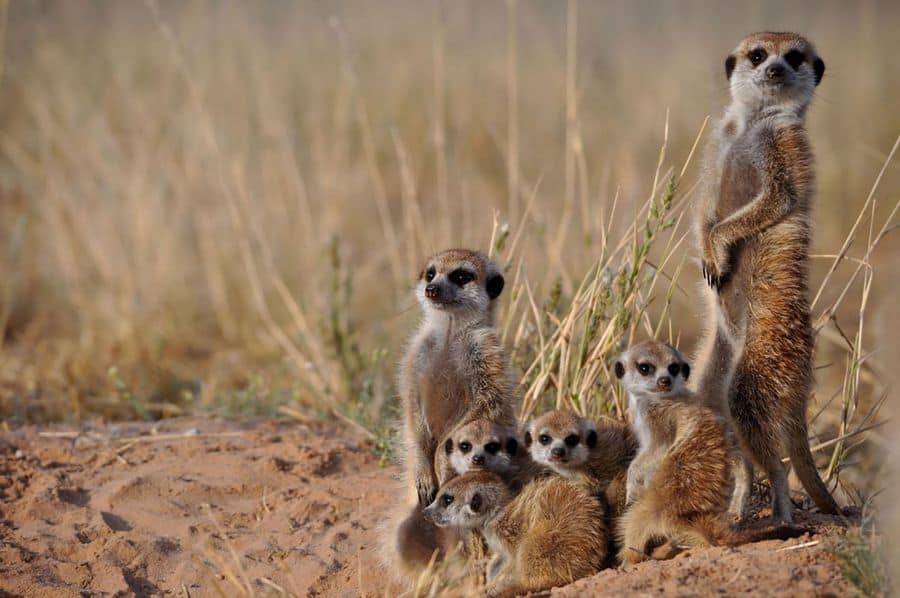On the sunbaked terrain of the Kalahari, a group of meerkats huddle together resembling a living compass, whiskers quivering, noses assessing the breeze. Recent findings indicate that their strong social bonds do more than protect against raptors and jackals. They also influence the gut bacteria that assist these creatures in thriving amidst a challenging desert environment.
In a study published in the Journal of Animal Ecology, scientists examined 528 fecal samples from 146 wild meerkats spread across eight social groups at South Africa’s Kuruman River Reserve. Utilizing network models and joint species distribution models, they assessed how group living, kinship, age, climate, and daily timing impacted microbiome composition and structure. One factor was particularly prominent: the identity of their companions.
## Social Living Imprints on Microbial Diversity
The research team identified 119 dominant bacterial taxa and discovered that microbiomes exhibited greater similarity within social groups compared to between them, even when accounting for time periods and other factors. This trend indicates substantial horizontal sharing through grooming, shared burrows, and collective foraging areas. It aligns with their network discovery of a primarily nested community, where many individuals share a common core of bacteria, while others contain subsets rather than entirely distinct groups.
Some of these shared microbes are recognized allies. Genera like Blautia and Roseburia are linked to the production of short-chain fatty acids and gut health, while Mucispirillum has been associated with pathogen protection. A few potentially concerning genera, including Fusobacterium and Campylobacter, also correlated with group affiliation, highlighting that social interactions can convey both benefits and risks.
> “The research also provides evidence that a meerkat’s microbiome can swiftly adapt upon joining a new group.”
This swift adaptation is crucial in a species where males frequently disperse. It suggests that newcomers may adopt the microbial profile of the resident group within weeks to months, likely gaining access to locally beneficial microbes suited to the group’s foraging environments, climate, and disease risks.
## Influence of Age, Timing, and Kinship Constraints
Age and the timing of sampling after sunrise significantly affected bacterial populations, reflecting previous studies that noted daily fluctuations and age-related stabilization in meerkat microbiomes. In contrast, kinship exerted a weaker overall influence compared to group membership, although in several groups, close relatives did exhibit more comparable microbiomes. Factors such as dominance status, sex, and recent immigration had less impact than social group, age, or daily timing.
Methodologically, the authors relied on contemporary community ecology techniques. They employed bipartite network analysis to investigate nested and modular structures, subsequently fitting Bayesian joint species distribution models that partitioned variance among social, biological, and environmental variables while also assessing microbe-microbe co-occurrence independently of host factors. The conclusion was evident: group membership and daily timing together accounted for a significant proportion of variance across numerous taxa, while individual identity and age contributed smaller segments.
> “Meerkats with less diverse microbiomes tended to maintain a subset of bacteria found in their more diverse companions, indicating the presence of a shared ‘core’ microbiome within each social group.”
For conservation and disease ecology, the implications are actionable. If social networks shape microbial exposure, then disruptions that fragment groups, modify dispersal, or alter daily activities could have cascading health effects via the microbiome. This finding bolsters a broader theory in behavioral ecology that suggests one reason social structures developed and endure is that they facilitate the sharing of beneficial microbes, in addition to information and protection.
There are limitations, which the authors acknowledge. The sequencing focused on the 16S V4 region, restricting strain-level resolution and functional insights. The models currently do not capture the precise sequence of microbial acquisition or differentiate indirect effects. Additionally, shared environments can mimic social transmission, a challenge that the field is still addressing through enhanced movement, contact, and metagenomic data.
Nevertheless, the desert imagery remains compelling. Envision a dawn foraging line weaving through camel thorn scrub, paws scuttling over undulating sand as the sun ascends. Each nuzzle, communal tunnel, and dust bath represents a potential exchange of microbes. For these diminutive carnivores, it seems that the company they choose is reflected in their guts, and that imprint may support their survival during the hottest days and leanest times.
_Peer reviewed study: Impact of animal socioecology on gut microbial communities: Insights from wild meerkats in the Kalahari._
[Journal of Animal Ecology: 10.1111/1365-2656.70168](https://doi.org/10.1111/1365-2656.70168)
**There’s no paywall here**
_If our reporting has informed or inspired you, please consider making a donation. Every contribution, no matter the size, empowers us to continue delivering accurate, engaging, and trustworthy science and medical news. Independent journalism requires time, effort, and resources—your
